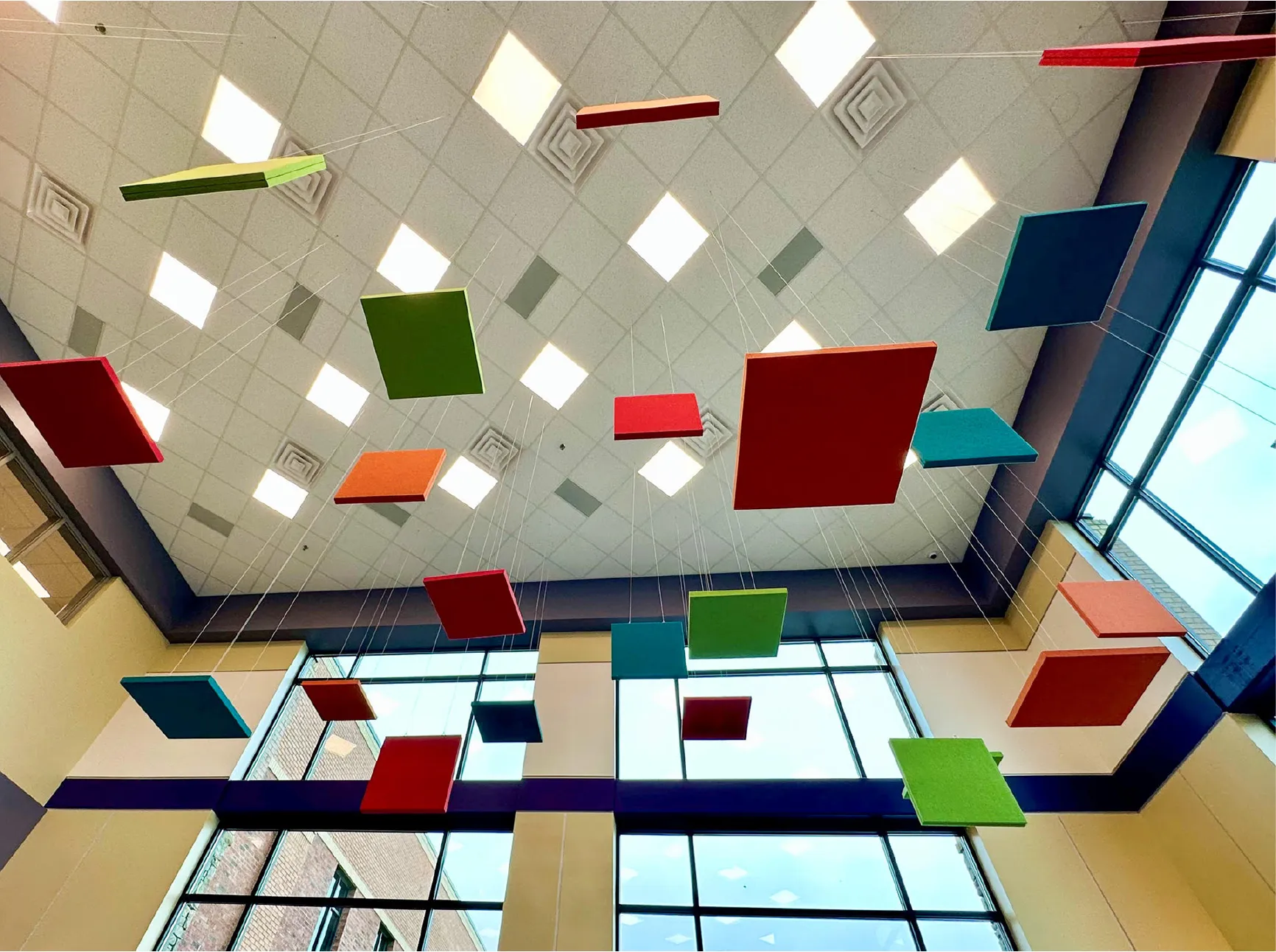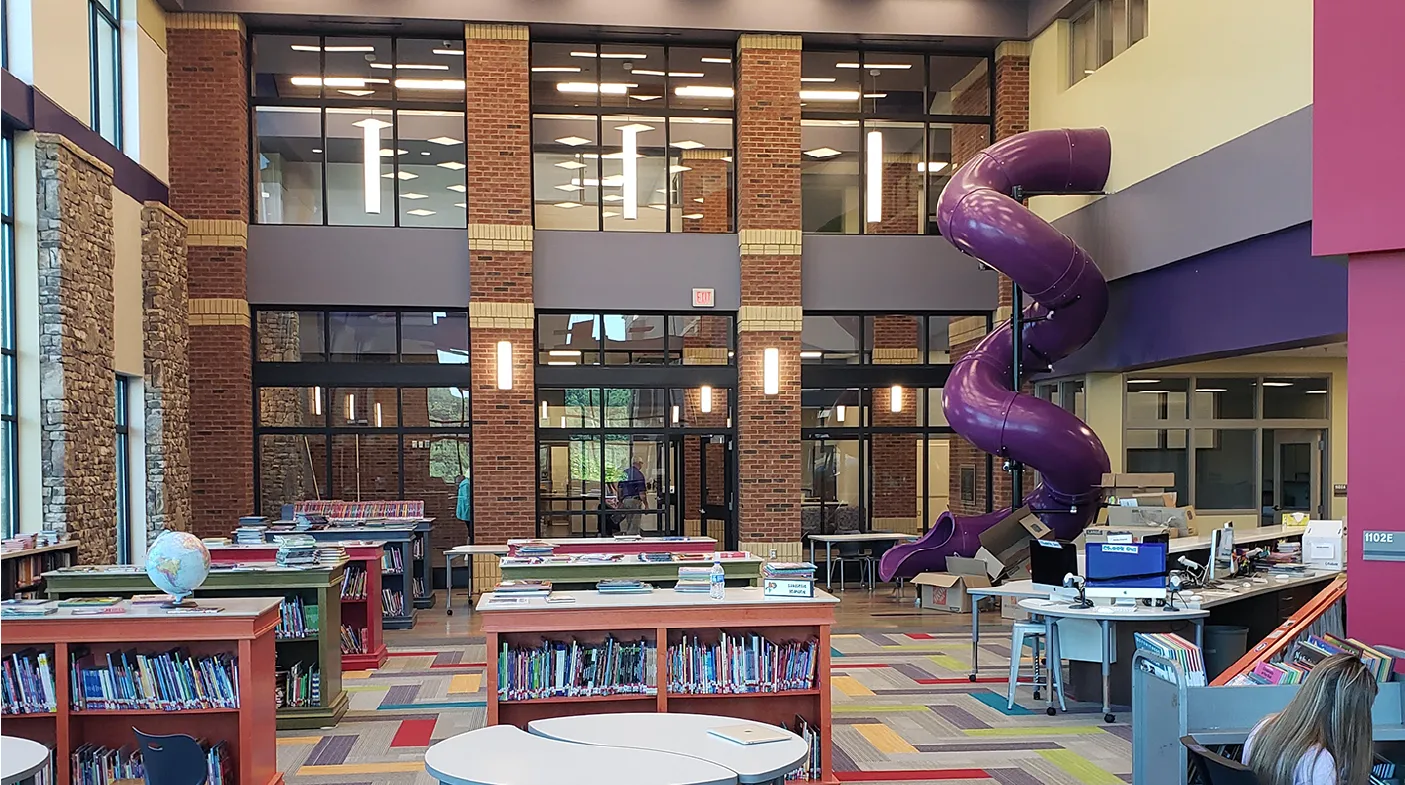School Shoutout: Sliding Into Success
This Georgia district built a school that its community is proud to champion, even if they have to wait their turn to slide.

The first day of school is always special, but in September 2023, students in Georgia’s Cottrell Elementary School were treated to the experience of a lifetime as they slid into their first day of school—literally. And it’s all thanks to their new elementary school’s defining feature: a two-story slide that ends in the school’s library.
Superintendent Dr. Rob Brown spent the new school’s opening day sitting at the bottom of the slide, welcoming students into a space where every detail had been designed for them. Brown, who retired in December 2023 after eight years with Lumpkin County Schools, recalls the first day of school at Cottrell as one of the best days of his entire career. “I couldn’t look away from the sheer delight on their faces,” he shares. “Every single kid who came down the slide was excited. One little girl was so giddy she couldn’t stand still.”
But while this was a new beginning for the district’s students, it was the culmination of years of hard work for the administrators and community members who had painstakingly planned each detail of the school. And for Brown, so close to retirement, it was also the capstone of eight years of strategic planning in the district.
The Foundations of a Promise
Lumpkin County Schools began brainstorming the future of Cottrell Elementary when Brown, then newly appointed, worked with a committee to develop the district’s strategic plan—including their long-term facilities plan. District leadership knew they would need to replace their aging elementary school in the next few years, but they expected their community to have strong feelings about replacing a space that had served generations of elementary students.
“Our old elementary school had so much going for it—it was centrally located and had a lot of tradition,” Brown explains. “But the building was aging, and its location made it a traffic headache.” However, finding a parcel of land that would meet their needs while still being centrally located would be a challenge. Lumpkin County’s county seat, Dahlonega, is small—less than nine square miles total—and land for new development can be hard to come by.
When the committee began looking for a parcel for the new elementary school, one location fit all of their needs, but it was far too expensive. Then one committee member suggested an exciting—if somewhat unique—plan. What if they partnered with the county to share the property for both district and county use?
In a lucky coincidence, the Lumpkin County government was looking for land to build a new aquatics center around the same time. That plus years of intentional partnership made the proposal an easy sell. “We have a community that really supports our schools, and we all knew that strengthening our partnership would only make things better for our community over all,” Brown says.
Together, the county and district approached the owners of the land, Lynn and Mike Cottrell. The sellers were so enthusiastic that they made a donation to the district in exchange for the chance to name the new elementary school. And so, years before the students would giddily slide into their new school, Cottrell Elementary was born.
While some residents expressed concern about changing the school’s name, Brown was quick to remind them that donations such as the Cottrells’ lightened the tax burden on the community as a whole. “It is important to us to show our community that we are careful stewards of the funds they provide us,” Brown says, “and that we are willing to think outside the box to make good things happen for our students.”

Planning for Every Detail
Like most districts, Lumpkin County Schools went through rounds of community and staff input to make decisions about the new school. After consulting with teachers, they decided to build bigger classrooms so that students could spread out. They also built indoor recess rooms where students could burn off energy whenever it was too cold—or too hot—to be outside. But when it came to what elementary schoolers need in the day-to-day, Brown and his team had something else to guide them: firsthand experience.
When Brown became a principal—and later a superintendent—he found himself reflecting often on his own time in the classroom. But he felt that having previous teaching experience wasn’t enough to keep him or his team rooted in what life in the classroom is like. So he implemented a policy requiring central office staff members to serve as substitutes at least once annually, reminding them what it’s like to experience Lumpkin County Schools from inside the classroom.
“When it came time to decide on the small details of the school, I used this insight to help me make decisions that could make my staff’s lives easier,” Brown tells us. “Whenever I sub, I’m always amazed at how often students ask to go refill their water bottles—so I asked the architect to put a water fountain with a dispenser in every classroom. I wanted them to have everything they needed—from sinks to wash their hands to space to spread out—without ever having to leave the room. When teachers asked for different things in their classrooms, it was easy for my cabinet to empathize with them because we had experienced the same issues while subbing in the old elementary school.”
Planning for all of these small details transformed the feeling of the school. In so many ways, it’s a building designed for children first—something that has definitely been well-received by the broader community. The school is bright and colorful and includes accents in the district’s signature purple. “During our ribbon-cutting, State Representative Chris Erwin said it was the most beautiful school he’s ever seen, and that filled our community with such pride,” Brown says. The former superintendent views the school’s design as an extension of the district’s overall mission. “If we want to develop and empower lifelong learners, we need facilities that match,” he explains.
But while the school as a whole is designed for student success, the committee was also thoughtful about how Cottrell Elementary could serve the broader community. The school has three meeting rooms for public use, something their community has desperately needed. And since the meeting rooms are only accessible from the outside, they can be reserved without impacting the day-to-day life of the school. But still, while every civic group in the area has toured the new school, it’s not the meeting rooms that have them talking—it’s the slide.
A Slide for Everyone
Because Brown started his career teaching physical education, he has a firsthand appreciation for how important movement is for the average elementary student. That knowledge made him want to design Cottrell Elementary School for the bouncy kids it would hold. So when it came time to plan the details for the school’s large library, Brown had a specific request: He wanted a slide.
Brown wanted Cottrell Elementary’s students to love their new building—and he wanted to extend that love to how they felt about reading in their new library. So he rang up the architects and made his big ask: a two-story slide starting near the classrooms and ending in the library. Brown says that while some stakeholders were bemused by the idea of an indoor slide—and worried that the extra costs associated with the project would be hard for their community to understand—his team dove headfirst into making his vision a reality. “When you consider the millions of dollars we spent on the school, the cost of the slide is not much at all,” Brown explains. “And the wow factor it gives is worth every penny.”
While the students may be big fans of the slide, they’re not the only ones. Staff members anticipated that their community would enjoy the meeting rooms built for their use—but Brown admits that no tour is complete until all of the adults have gone down the slide. “I assure them all that it’s made for everyone, including big guys like me,” Brown jokes. “We have an 84-year-old gentleman in our community who prides himself on being the oldest person to go down the slide so far. It’s the first thing every community group asks about, and we love knowing that we really have created a space for everyone.”
While the swirling purple slide may be the most noticeable and thoughtful detail in the school, Cottrell Elementary as a whole has quickly become the pride of its community. Its design also supports the district’s plans to bolster their overall enrollment growth over the next decade. When families tour Cottrell Elementary School, it is clear that their children will not only learn there, but thrive.
“Last week, I learned that one of our local employers includes pictures of our elementary school in the materials they use to recruit people from out of state,” Brown says, beaming. “When we set out on this project, we knew that we would need our community’s support—but it feels great to know that we’re supporting our community’s growth, too.”
While Brown is excited about his retirement, the story is only beginning for Cottrell Elementary and the generations of students it will nurture. The community’s new recreation and aquatics center is under construction next door and will open later this year. “There are few things more exciting for your community than opening a new school,” Brown shares. “But Cottrell Elementary really is a testament to the amazing things that can happen when district-community partnerships are strong and people are willing to think big about how to best support kids.”

Subscribe below to stay connected with SchoolCEO!


